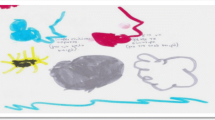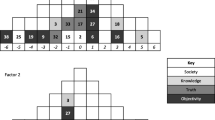Abstract
How do we see young children's thinking in science? Is it, as much previous research has led us to believe, that their ideas can be neatly boxed like “brown paper packages tied up with strings” – as the song from The Sound of Music goes? Or are their ideas like “wild geese that fly with the moon on their wings” (Sound of Music): fluid, complex, rich. . .? Drawing on the author's research into young children's ideas about natural phenomena such as the rain and clouds, and on Rogoff's three foci of analysis (personal, interpersonal and contextual), this paper illustrates how a consideration of sociocultural theory can be useful in framing research with young children, and allow us to see beyond the boxes. Emphasis is placed on recognising that children's thinking in science is embedded within particular sociocultural contexts, is guided by others and integrated with their use of certain mental and physical cultural tools. Thus, the article aims to present an alternative method for the generation of data on young children's thinking. Specific analysis of this data will, it is intended, be presented in a subsequent article.
Similar content being viewed by others
References
Alloway, N. (1997). Early childhood education encounters the postmodern: What do we know? What can we count as ‘true’? Australian Journal of Early Childhood, 22(2), 1–5.
Bar, V. (1989). Children's views about the water cycle. Science Education, 73(4), 481–500.
Bliss, J. (1993). The relevance of Piaget to research in children's conceptions. In P. J. Black & A. M. Lucas (Eds.), Children's informal ideas in science (pp. 20–44). London: Routledge.
Cannella, G. S., & Bailey, C. (1999). Postmodern research in early childhood education. In S. Reifel (Ed.), Advances in early education and day care (Vol. 10). Stamford, CT: JAI Press.
Cobern, W. W. (1996). Constructivism and non-Western science education research. International Journal of Science Education, 18(3), 295–310.
Daniels, H. (2001). Vygotsky and Pedagogy. London: Falmer Press.
Dove, J. (1998). Alternative conceptions about the weather. School Science Review, 79(289), 65–69.
Dove, J. E., Everett, L. A., & Preece, P. F. W. (1999). Exploring a hydrological concept through children's drawings. International Journal of Science Education, 21(5), 485–497.
Driver, R., Asoko, H., Leach, J., Mortimer, E., & Scott, P. (1998). Constructing scientific knowledge in the classroom. In D. Faulkiner, K. Littleton, & M. Woodhead (Eds.), Learning relationships in the classroom (pp. 258–275). London: Routledge.
Edens, K., & Potter, E. (2003). Using drawing as a conceptual change strategy in elementary science. School Science and Mathematics, 103(3), 103–144.
Edwards, A. (2000). Research and practice: Is there a dialogue? In H. Penn (Ed.), Early childhood services: Theory, policy and practice (pp. 184–199). Buckingham, UK: Open University Press.
Fleer, M. (2002a). Sociocultural assessment in early childhood education – Myth or reality? International Journal of Early years Education, 10(2), 105–120.
Fleer, M. (2002b). Sociocultural theory: Rebuilding the theoretical foundations of early childhood education. Policy and Practice in Education, 54(1), 105–120.
Fleer, M., & Robbins, J. (2002, December). ‘He lie down and watch the satellite going over.’ Science education meets sociocultural theory. Invited keynote: Contemporary Issues in Science, Mathematics and Technology Symposium. Deakin University, Melbourne.
Fleer, M., & Robbins, J. (2003). “Hit and run” research with “Hit and miss” results in early childhood education. Research in Science Education, 33(4), 405–431.
Gauvain, M. (1998). Thinking in niches: Sociocultural influences on cognitive development. In D. Faulkiner, K. Littelton, & M. Woodhead (Eds.), Learning relationships in the classroom (pp. 67–89). London: Routledge.
Göncü, A. (1999). Children's and researchers' engagement in the world. In A. Göncü (Ed.), Children's engagement in the world: Sociocultural perspectives (pp. 3–21). Cambridge, UK: Cambridge University Press.
Hammerstein, O. (1959). My favorite things. In R. Rodgers & O. Hammerstein, The Sound of Music. London: Williamson Music.
Hayes, D., & Symington, D. (1988). Purposes achieved by drawing during art activities. Research in Science Education, 18, 104–111.
Hayes, D., Symington, D., & Martin, M. (1994). Drawing during science activity in the primary school. International Journal of Science Education, 16(3), 265–277.
Henriques, L. (2002). Children's ideas about weather: A review of the literature. School Science and Mathematics, 102(5), 202–213.
Hills, G. L. (1989). Students' “untutored” beliefs about natural phenomena: primitive science or commonsense? Science Education, 73(2), 155–186.
Hodson, D. (1998). Teaching and learning science: Towards a personalized approach. Buckingham, UK: Open University Press.
John-Steiner, V., & Mahn, H. (1996). Sociocultural approaches to learning and development: A Vygotskian framework. Educational Psychologist, 31(3/4), 191–206.
Lemke, J. L. (2001). Articulating communities: Sociocultural perspectives on science education. Journal of Research in Science Teaching, 38(3), 296–316.
Marín, N., Benarroch, A., & Jiménez Gómez, E. (2000). What is the relationship between social constructivism and Piagetian constructivism? An analysis of the characteristics of the ideas within both theories. International Journal of Science Education, 22(3), 225–238.
O'Loughlin, M. (1992). Rethinking science education: Beyond Piagetian constructivism toward a sociocultural model of teaching and learning. Journal of Research in Science Teaching, 29(8), 791–820.
Osborne, R. (1985). Building on children's intuitive ideas. In R. Osborne & P. Freyberg (Eds.), Learning in science: The implications of children's science (pp. 41–50). Auckland, New Zealand: Heinemann.
Penn, H. (2000). How do children learn? Early childhood services in a global context. In H. Penn (Ed.), Early childhood services: Theory, policy and practice (pp. 7–14). Buckingham, UK: Open University Press.
Piaget, J. (1973). The child's conception of the world. St. Albans, Herts: Paladin.
Philips, W. C. (1991). Earth science misconceptions. The Science Teacher, February 21–23.
Robbins, J. (2002). Shoes and ships and sealing wax – Taking a sociocultural approach to interviewing young children. New Zealand Research in Early Childhood Education, 5, 13–30.
Robbins, J. (2003). Moving through understanding rather than to understanding: A sociocultural perspective on young children's conceptions of the rain. Journal of Australian Research in Early Childhood Education, 10(1), 93–108.
Rogoff, B. (1995). Observing sociocultural activity on three planes: Participatory appropriation, guided participation, and apprenticeships. In J. V. Wertsch, P. Del Rio, & A. Alvarez (Eds.), Sociocultural studies of mind (pp. 139–164). Cambridge, UK: Cambridge University Press.
Rogoff, B. (1997). Evaluating development in the process of participation: Theory, methods, and practice building on each other. In E. Amsel & K. A. Renninger (Eds.), Change and development: Issues of theory, method and application (pp. 265–285). Mahwah, NJ: Lawrence Erlbaum.
Rogoff, B. (1998). Cognition as a collaborative process. In W. Damon (Chief Ed.) and D. Kuhn & R. S. Siegler (Volume Eds.), Cognition, perceptions and language (5th ed.), Handbook of child psychology (pp. 679–744). New York: John Wiley & Sons.
Rogoff, B., & Chavajay, P. (1995). What's become of research on the cultural basis of cognitive development. American Psychologist, 50(10), 859–875.
Russell, T., Bell, D., Longden, K., & McGuigan, L. (1993). Primary SPACE project research report: Rocks, soil and weather. Liverpool, UK: Liverpool University Press.
Shepardson, D. P. (2002). Bugs, butterflies, and spiders: Children's understandings about insects. International Journal of Science Education, 24(6), 627–643.
Solomon, J. (1993). The social construction of children's scientific knowledge. In P. J. Black & A. M. Lucas (Eds.), Children's informal ideas in science (pp. 85–101). London: Routledge.
Spiropoulou, D., Kostopoulos, D., & Jacovides, C. P. (1999). Greek children's alternative conceptions on weather and climate. School Science Review, 81(194), 55–59.
Sprod, T., & Jones, B. L. (1997). “The sun can't bounce of a bird”: Young children and their understanding of vision. Australian Journal of Early Childhood, 22(2), 29–33.
Stepans, J., & Kuehn, C. (1985). What research says: Children's conceptions of weather. Science and Children, 23(1), 44–47.
Stetsenko, A. P. (1999). Social interaction, cultural tools and the zone of proximal development: In search of synthesis. In S. Chaiklin, M. Hedegaard, & U. J. Jensen (Eds.), Activity theory and social practice: Cultural-historical approaches (pp. 235–252). Aarhus, Denmark: Aarhus University Press.
Taiwo, A. A., Ray, H., Motswiri, M. J., & Masene, R. (1999). Perceptions of the water cycle among primary school children in Botswana. International Journal of Science Education, 21(4), 413–429.
Tytler, R. (2000). A comparison of Year 1 and Year 6 students' conceptions of evaporation and condensation: Dimensions of conceptual progression. International Journal of Science Education, 22(5), 447–467.
Tytler, R., & Peterson, S. (2000). Deconstructing learning in science – Young children's responses to a classroom sequence on evaporation. Research in Science Education, 30(4), 339–355.
Welzel, M., & Roth, W. M. (1998). Do interviews really assess students' knowledge? International Journal of Science Education, 20(1), 25–44.
Watson, L. (1997). Children's misconceptions and conceptual change. Australian Journal of Early Childhood, 22(2), 12–16.
Wertsch, J. V. (1991). Voices of the mind: A sociocultural approach to mediated action. Cambridge, MA: Harvard University Press.
Woodhead, M. (2000). Towards a global paradigm for research into early childhood. In H. Penn (Ed.), Early childhood services: Theory, policy and practice (pp. 15–35). Buckingham, UK: Open University Press.
Author information
Authors and Affiliations
Corresponding author
Rights and permissions
About this article
Cite this article
Robbins, J. ‘Brown Paper Packages’? A Sociocultural Perspective on Young Children's Ideas in Science. Res Sci Educ 35, 151–172 (2005). https://doi.org/10.1007/s11165-005-0092-x
Issue Date:
DOI: https://doi.org/10.1007/s11165-005-0092-x




